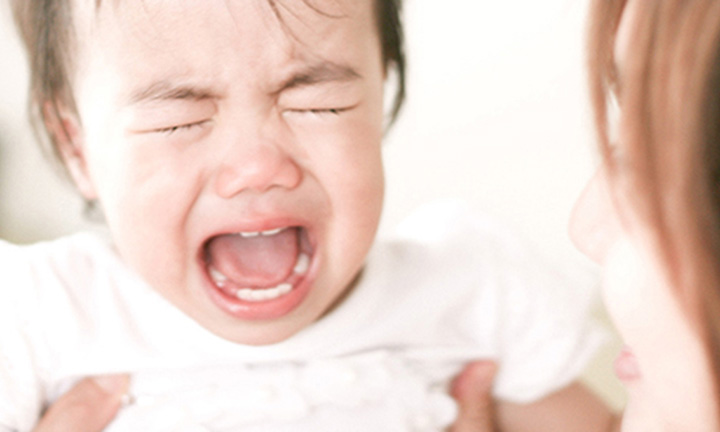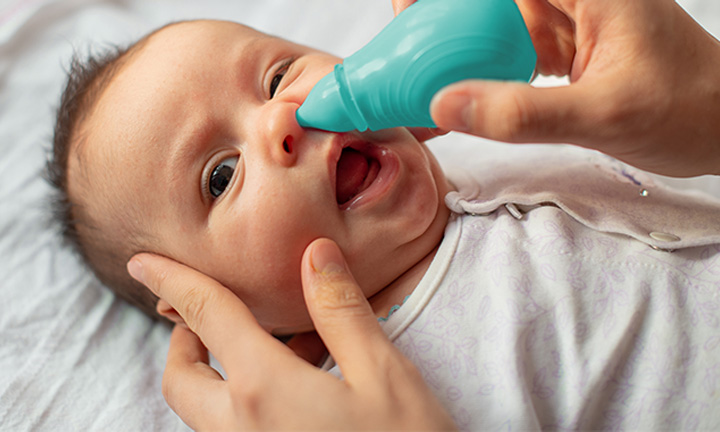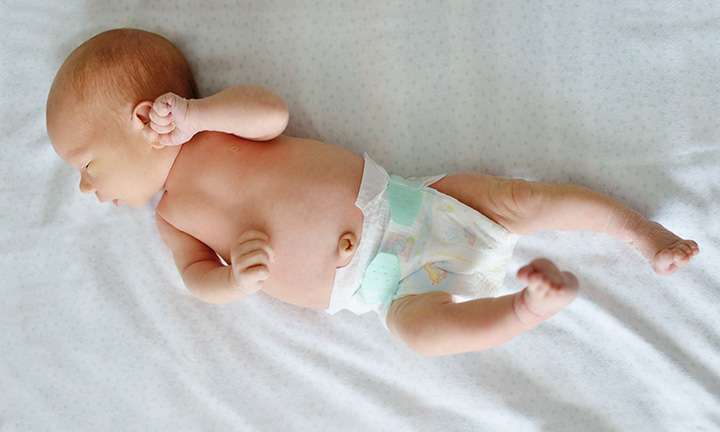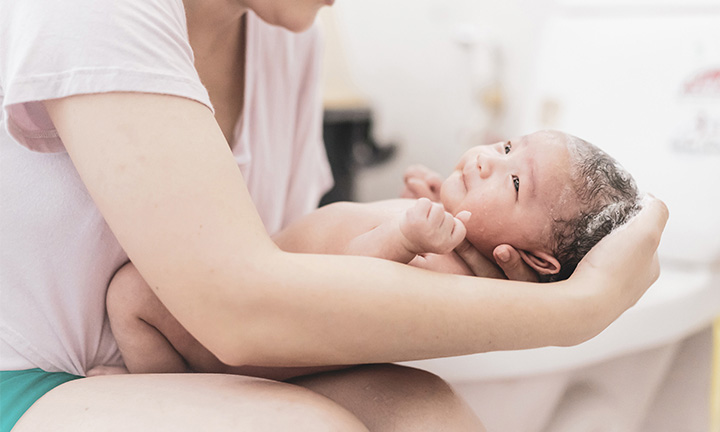
Gassy Baby: How to Relieve Your Baby’s Gas
4 min readUpdated October 24, 2025

MD, FAAP
4 min readUpdated October 24, 2025

MD, FAAP
Wondering, “Why is my baby so gassy?” While it's normal for newborns to experience gas due to their immature digestive systems, there are several effective strategies to ease their discomfort. Common causes of infant gas include swallowing air during feeding or crying, sensitivity to certain foods in a breastfeeding parent’s diet, or issues with formula preparation. Helpful remedies include:
While gas drops (simethicone) may offer relief for some, evidence is mixed. Always consult your healthcare provider before making dietary changes or trying new treatments. In the sections below, we’ll explore how to help relieve your baby’s gas and more.
What Causes Gas in Newborns?
Starting with the first feeding, babies shift from obtaining nutrients from the placenta to drinking and digesting breast milk or formula. That’s a big adjustment for a small digestive system that’s still developing, and it’s a chief reason that gas naturally occurs in infants.
Overall, it takes time for your little one’s gastrointestinal tract to fully develop and build a microbiome (the mix of tiny organisms in the body, including healthy gut bacteria). And when a still-developing digestive system is challenged by too much air being swallowed, as often happens during a feeding, you’re even more likely to have a gassy baby.
Why Is My Baby So Gassy?
There’s no reason to be embarrassed by this question—you’re not the only parent asking! Excess infant gas can result from several different factors, especially if you notice your baby crying or screaming in pain from gas.
What Foods Can Cause Gas in Breastfed Babies?
While breast milk is the optimal source of nutrition for infants, certain foods consumed by breastfeeding parents may influence a baby's digestion, potentially leading to gas and discomfort. Identifying these foods can be challenging, as reactions vary among infants. However, these are among the most commonly reported foods that cause gas in breastfed babies:
Not all babies will be affected by these foods, and it’s important not to eliminate entire food groups without professional guidance. If you suspect certain foods are causing gas in your breastfed baby, try tracking your meals and your baby’s symptoms in a food diary. Always consult your healthcare provider before making significant changes to your breastfeeding diet.
Gassy Baby Symptoms
You may notice your baby is gassy when you smell or hear something unusual. Other signs and symptoms of infant gas include:
How to Relieve Your Baby’s Gas
So, what are the best remedies for infant gas? There are plenty of effective strategies and home remedies to help your newborn baby with gas problems. The trick is to break up the gas bubbles that have formed in the abdomen and digestive tract. The following strategies and remedies may help to offer natural gas relief for infants.
1. Burp During and After Feedings
Because gas bubbles tend to form from the air that sneaks in during feeding, burping is your friend. It releases air that can turn into gas bubbles in the tummy. Although it’s standard practice to burp your baby after feeding them if they suffer from gas, you can try burping during feeding as well. This can help provide your baby with some gas relief, especially at night when feeding before bed.
2. Encourage Slow Eating
If your baby eats too fast, they tend to swallow more air and develop more gas bubbles. You can encourage slower eating by using a bottle with a slow-flow nipple. If you’re breastfeeding and experiencing an oversupply of breast milk, speak to your healthcare provider or a lactation consultant.
3. Use the Right Bottle
Slow-flow nipples can be a game-changer, just like slow-flow, vented, angled, or collapsible baby bottles. These types are designed by professionals to minimize the amount of air your baby swallows while feeding.
4. Identify Food Sensitivities
If your little one appears particularly uncomfortable after being breastfed, they could be sensitive to the foods you’re eating. You can try to identify these foods and eliminate them from your diet for at least one week to see if it helps your gassy baby. As mentioned earlier, common foods that might cause gas in breastfed babies include cruciferous vegetables, like broccoli, and dairy products.
5. Change Formula
Determining the best formula for gassy babies depends on individual needs. Generally, experts recommend formulas based on cow's milk. However, if your baby has a milk protein allergy a hypoallergenic formula should be used.
If you’re considering swapping formulas, it’s best to consult your child’s healthcare provider. A gassy baby might not need to change to a different formula, but the provider will be able to address the problem and help you successfully switch if needed.
Tip
Always consult your child’s healthcare provider before switching formulas and changing your baby’s diet. Sometimes, the culprit isn’t the formula itself, and another remedy may be the better solution.
Positions to Help Release Gas in Infants
If your baby is gassy and uncomfortable, certain positions can help move those air bubbles along and soothe their tummy. Understanding how to release gas in infants is key to easing their discomfort. These gentle movements and postures support your baby’s digestive system and are simple, safe ways to offer relief at home.
Gas Relief Drops for Babies
In searching for how to help a baby with gas, some parents choose to try baby gas drops. Gas medicine for babies doesn’t always work, but it could be worth a try if other remedies don’t provide any relief.
Baby gas drops typically use simethicone, which causes an antifoaming effect to relieve bloating and pain caused by gas. It’s generally thought to be safe for babies, but make sure you read the label and instructions, so you know how much to give your baby. Always consult your child’s healthcare provider before giving your newborn or young baby any medicine, even over-the-counter varieties.
When to Contact Your Baby’s Healthcare Provider
Gas is a common and usually harmless part of infancy. However, understanding when to seek medical advice can help ensure your baby's health and your peace of mind.
If you're ever uncertain about your baby's symptoms or behaviors, it's always best to consult with your healthcare provider. Trusting your instincts and seeking professional advice can help ensure your baby's well-being.
FAQS AT A GLANCE
To alleviate gas in infants, consider these strategies:
- Burp your baby during and after feedings.
- Ensure a proper latch when breastfeeding and use slow-flow nipples for bottle-feeding.
- Try gentle tummy exercises, like laying them on their back and bicycling their legs.
- Keep your baby upright during and after feedings.
- If breastfeeding, monitor your diet for gas-inducing foods and consult your provider if needed.
The Bottom Line
Yes, a gassy baby is normal, but of course, you may still want to know how to help your baby with gas. Chances are that the problem is just temporary as your newborn develops a strong digestive system and gets used to a new diet of breast milk or formula. Use the information above to understand how to relieve baby gas.
If the gas is intense or causing your baby pain, talk to your child’s healthcare provider. Your little one may have a food allergy or simply need a different type of formula. Just remember that babies cry to communicate and that you’re doing a great job! Gas is normal, cries are normal, and your child’s healthcare provider is there to help when needed.
Read more about how your baby develops in their first few months and download the Pampers Rewards app to earn rewards on all your Pampers purchases. Don’t forget to scan the QR code on all your diaper packs!
- American Academy of Pediatrics. Caring for Your Baby and Young Child: Birth to Age 5, 7th ed. (New York: Bantam Books, 2019).
- Healthy Children. “Baby Burping, Hiccups, & Spit-Up.”
- Healthy Children. “Gas Relief for Babies.”
- Healthy Children. “How to Calm a Fussy Baby.”
- Healthy Children. “Lactose Intolerance in Infants and Children.”
- Healthy Children. “Why Babies Spit Up.”
- Healthy Children. “11 Common Conditions in Newborns.”
- Kids Health. “Breastfeeding FAQs.”
- Kids Health. “Burping Your Baby.”
- Kids Health. “Communication and Your 1- to 3-Month-Old.”
- Kids Health. “Formula Feeding FAQs.”
- LLLI. “Feed the Baby—And the Microbes.”
- Mayo Clinic. “Colic.”
- Mayo Clinic. “Sick Baby? When to Seek Medical Attention.”
- MedlinePlus. “Abdominal Pain.”
- MedlinePlus. “Changes in the Newborn at Birth.”
- NIH. “Development of the Digestive System.”
Read more about Baby
Related Articles
Join a World of Support
through Pregnancy and Parenthood.
TRACK WITH TOOLS
LEARN WITH EXPERTS
GET REWARDED














